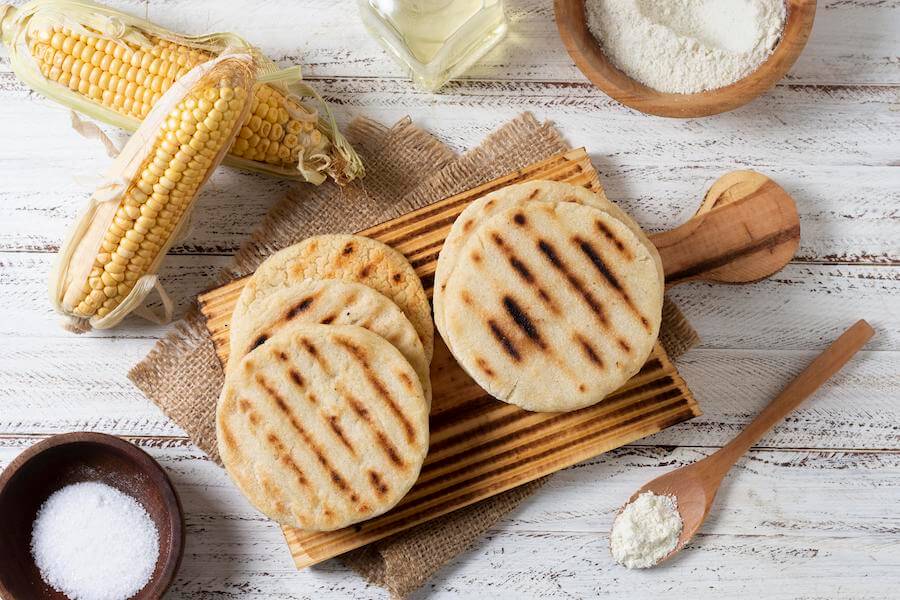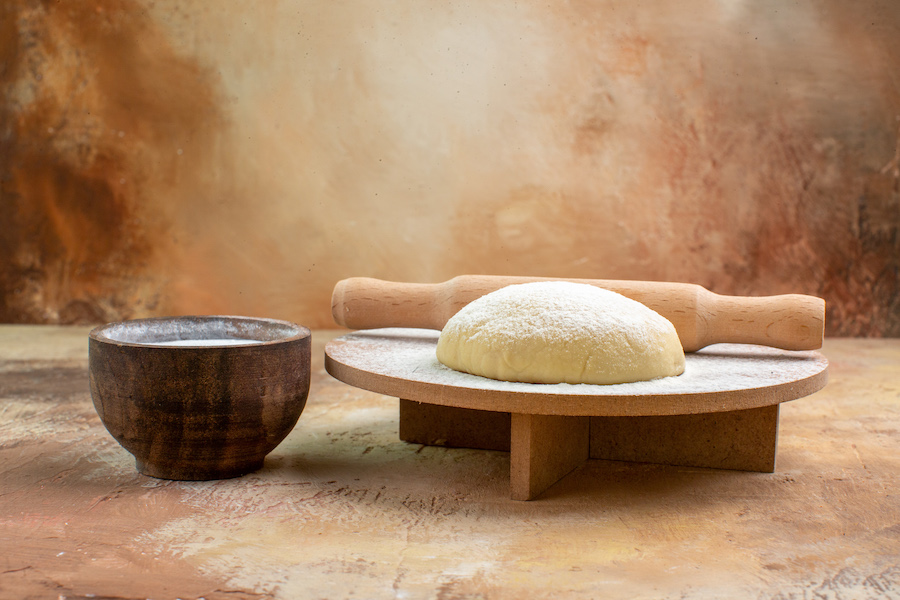Welcome to our culinary journey through Latin America, where we delve into the delicious world of corn-based staples: Maseca and Masarepa.

While both originate from maize, these iconic ingredients play unique roles in the vibrant tapestry of Latin American cuisine. In this blog post, we’ll explore the distinct characteristics, culinary applications, and cultural significance of Maseca and Masarepa.
From the soft, pliable tortillas of Maseca in Mexico to the irresistible arepas of Masarepa fame in Colombia and Venezuela, we’ll uncover the secrets behind these versatile ingredients, inviting you to savor the flavors and textures that define Latin American cooking.
What is Maseca?
Maseca, a renowned brand in Mexican and Central American kitchens, is masa harina, a unique corn flour. It’s created through the ancient practice of nixtamalization, where corn is cooked with an alkaline solution, such as lime, transforming its texture and flavor.
Versatility of Maseca
Maseca’s adaptability shines in Mexican cuisine. It’s the cornerstone of tortillas, tamales, and pupusas, offering a versatile canvas for countless dishes. Let’s delve deeper into its role in crafting these beloved Latin American treats.
What is Masarepa?
Masarepa, a cherished staple in South American cuisine, particularly in Colombia and Venezuela, is the counterpart to Maseca in the north. This corn-based gem is born from a unique cooking process.
Corn kernels are cooked in water with a dash of salt and then finely ground to create Masarepa. Unlike nixtamalization, this process produces a distinctly textured cornmeal perfect for crafting a South American favorite: arepas.
Arepas: The Star of Masarepa
Arepas, round and flat, like thick pancakes, are the stars of the Masarepa show. They’re a culinary treasure in Colombia and Venezuela, where they’re enjoyed daily.
Masarepa is the crucial ingredient that gives arepas their characteristic taste and texture. These versatile bread-like pockets can be filled with various delicious fillings, making them a beloved comfort food symbol of South American culture.
Join us as we uncover the art of making these delectable arepas and explore their cultural significance in the heart of South America.

Comparing Maseca and Masarepa
Ingredients and Processing
Let’s take a closer look at what sets Maseca and Masarepa apart. Maseca’s distinctive flavour and aroma arise from the intricate process of nixtamalisation.
During this age-old practice, corn kernels undergo a transformative journey. They’re soaked and simmered in an alkaline solution, often featuring lime (calcium hydroxide).
This unique method imparts a subtly tangy taste and infuses Maseca with its characteristic scent.In contrast, Masarepa’s charm lies in its simplicity.
Creating Masarepa begins with corn kernels cooked in water and salt. The resulting masa is then finely ground to produce Masarepa. This minimalistic approach makes a more neutral taste, allowing it to adapt quickly to various dishes.
Culinary Applications
Maseca and Masarepa, while both corn-based, have carved distinct culinary identities in their respective regions. Maseca, reigning supreme in Mexican and Central American kitchens, is vital in crafting traditional dishes.
It’s the backbone of the beloved tortillas, those thin, pliable flatbreads that accompany countless meals. Maseca also shines in the realm of tamales, where it envelopes savory or sweet fillings in a soft, comforting masa blanket.
And remember pupusas, thick and stuffed tortillas from El Salvador, where Maseca’s versatility knows no bounds.
On the other hand, masarepa reigns supreme in Colombia and Venezuela. Its signature creation, the arepa, takes center stage. Arepas are round and flat, akin to thick pancakes, but their magic lies in their unique texture.
Masarepa’s distinct grind results in a dough that is neither too dense nor too airy, creating the perfect canvas for a wide array of fillings.
These delectable pockets of flavour have earned their place as a beloved comfort food, cherished by locals and celebrated worldwide.
It becomes evident that these corn-based ingredients play pivotal roles in the diverse and rich tapestry of Latin American cuisine, each adding its unique touch to traditional dishes.
The following section will explore how these ingredients influence taste and texture, further distinguishing their culinary roles.
Taste and Texture Comparison
Flavor Profile
The taste of Maseca and Masarepa offers a captivating contrast. Maseca, with its nixtamalisation roots, boasts a subtly tangy and earthy flavour profile.
Including lime during processing contributes to its unique taste, making it a key ingredient in defining the flavors of Mexican and Central American dishes.
Whether it’s the comforting warmth of a fresh tortilla or the rich flavors of a tamale, Maseca’s distinct taste enhances every dish it graces.
In comparison, Masarepa takes a more neutral approach to flavor. The absence of lime in its preparation results in a milder taste, acting as a versatile canvas for various fillings.
Its neutral profile allows it to seamlessly adapt to savory and sweet dishes, making it the perfect partner for crafting the beloved arepas of Colombia and Venezuela.
Texture and Consistency
Beyond flavor, texture plays a significant role in distinguishing these corn-based staples. Maseca, with its nixtamalisation process, yields a pliable, soft, and slightly chewy masa.
This texture is ideal for crafting thin, flexible tortillas and tamales with just the proper bite. It’s a testament to the skill and tradition embedded in Mexican and Central American cooking.
Conversely, masarepa’s grind results in a slightly more firm and thicker dough. This unique texture defines arepas. It’s not too dense or too airy, striking the perfect balance.
Arepas, when cooked to perfection, possess a crisp outer layer while maintaining a soft, comforting interior. This texture is integral to what makes arepas so beloved in Colombia and Venezuela.
It’s remarkable how variations in processing and regional traditions can influence these corn-based ingredients’ flavor, texture, and consistency.
In the next section, we’ll explore their global availability and accessibility, shedding light on where you can savor these culinary gems beyond their places of origin.
Availability and Accessibility
Global Availability
The popularity of Maseca and Masarepa has transcended their regions of origin, making them sought-after ingredients worldwide.
Maseca’s influence has spread far beyond Mexico and Central America, reaching international markets, especially in areas with a significant Latin American population.
You can often find Maseca in well-stocked grocery stores and Latin American markets in North America, Europe, and other parts of the world, allowing enthusiasts to recreate authentic dishes from the comfort of their homes.
Similarly, Masarepa, associated with arepas, has made its mark globally. Colombian and Venezuelan communities worldwide have introduced arepas to local cuisine, and as a result, Masarepa has become increasingly accessible.
You can discover Masarepa in Latin American stores and even some mainstream supermarkets, making it easier for people to try their hand at crafting these delicious arepas.

Substitutes and Alternatives
If you can’t find Maseca or masarepa in your local stores, don’t despair. There are suitable substitutes and alternatives available that can help you capture the essence of Latin American cuisine.
For Maseca, you can consider using other though the flavor and texture may vary slightly. Experimenting with different brands can also yield satisfying results.
Regarding masarepa and arepas, look for other corn flour or fine cornmeal, ideally labeled as “precooked” or “pre-hydrated.”
These can create a similar dough for arepas, allowing you to enjoy this South American delicacy even if Masarepa is not readily available.
Conclusion:
In conclusion, while Maseca and Masarepa have their roots in specific regions, their global availability and versatile nature ensure that you can explore the flavors of Latin American cuisine regardless of where you are.
So, don’t hesitate to embark on your culinary journey and savor the taste of these corn-based gems.
